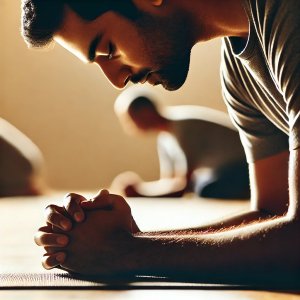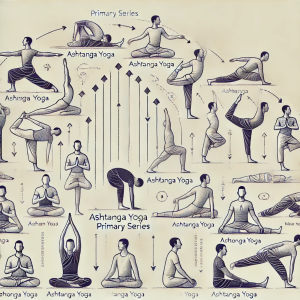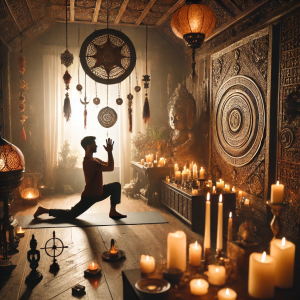By: Dr. Priya Sharma, Tantric Yoga Instructor and Holistic Sexuality Educator
Ashtanga Yoga is a dynamic and rigorous style of yoga that emphasizes strength, flexibility, and discipline. Rooted in ancient traditions, Ashtanga Yoga follows a specific sequence of postures that are linked together with breath (vinyasa), creating a powerful and transformative practice. This article explores the principles, benefits, and practices of Ashtanga Yoga, providing insights into how it can be integrated into your daily routine for holistic health.

Understanding Ashtanga Yoga
Ashtanga Yoga, developed by Sri K. Pattabhi Jois, is based on the ancient text “Yoga Korunta.” The word “Ashtanga” means “eight limbs,” referring to the eightfold path outlined by Patanjali in the Yoga Sutras. This path includes ethical principles, physical postures, breath control, sensory withdrawal, concentration, meditation, and ultimately, samadhi (union with the divine).

Core Elements of Ashtanga Yoga
- Asanas (Physical Postures): Ashtanga Yoga follows a specific sequence of postures, known as the primary series, intermediate series, and advanced series. Each series is designed to purify the body and mind, building strength, flexibility, and endurance. Common poses include Surya Namaskar (Sun Salutation), Trikonasana (Triangle Pose), and Paschimottanasana (Seated Forward Bend).
- Vinyasa (Breath-Synchronized Movement): Vinyasa is the linking of breath with movement, creating a continuous flow between postures. This dynamic practice enhances the mind-body connection, improves cardiovascular health, and increases energy levels.
- Drishti (Gaze Points): Drishti refers to specific points of focus used during the practice to enhance concentration and inner awareness. Common drishti points include the tip of the nose, the navel, and the fingertips.
- Bandhas (Energy Locks): Bandhas are internal energy locks that help to control the flow of prana (life force energy) in the body. The three main bandhas used in Ashtanga Yoga are Mula Bandha (Root Lock), Uddiyana Bandha (Abdominal Lock), and Jalandhara Bandha (Chin Lock).
- Ujjayi Pranayama (Victorious Breath): Ujjayi is a breathing technique that involves inhaling and exhaling through the nose with a slight constriction in the throat. This creates a soothing, ocean-like sound that helps to focus the mind and regulate the breath.

The Benefits of Ashtanga Yoga
- Physical Strength: Ashtanga Yoga builds physical strength through a series of challenging postures that engage and tone all major muscle groups.
- Flexibility: The practice improves flexibility by stretching and lengthening the muscles, promoting greater range of motion.
- Endurance: The continuous flow of movement in Ashtanga Yoga increases cardiovascular endurance and stamina.
- Mental Clarity: The combination of breath control, gaze points, and dynamic movement in Ashtanga Yoga promotes mental clarity and concentration.
- Emotional Balance: Ashtanga Yoga supports emotional well-being by releasing tension and stress, fostering mindfulness, and cultivating self-awareness.
- Spiritual Growth: Ashtanga Yoga provides a pathway to spiritual growth by fostering a deeper connection with the self and the universe. The practice encourages introspection, self-discovery, and a sense of unity with the divine.

Incorporating Ashtanga Yoga into Your Daily Routine
To fully benefit from Ashtanga Yoga, it is important to incorporate it into your daily routine. Here are some tips to get started:
- Create a Dedicated Space: Designate a quiet and peaceful area in your home for your yoga practice. This space can include a yoga mat, props (like blocks and straps), and items that inspire you, such as candles, crystals, and spiritual symbols.
- Set a Regular Practice Time: Establish a consistent time each day for your Ashtanga Yoga practice. Morning sessions are ideal for setting a positive tone for the day.
- Start with the Primary Series: Begin with the primary series of Ashtanga Yoga, focusing on mastering each pose and transition. Gradually progress to the intermediate and advanced series as your practice evolves.
- Focus on Breath and Alignment: Pay attention to your breath and alignment in each pose. Use Ujjayi breath to maintain a steady rhythm and enhance concentration.
- End with Relaxation: Always conclude your practice with a relaxation pose, such as Savasana. This allows the body and mind to integrate the benefits of the practice and promotes a sense of peace and well-being.

Exploring Advanced Ashtanga Yoga Practices
As you become more comfortable with Ashtanga Yoga, you may want to explore advanced practices to deepen your experience. Here are some techniques to consider:
- Bandhas (Energy Locks): Bandhas are techniques that lock and direct the flow of energy within the body. Practicing bandhas like Mula Bandha (Root Lock), Uddiyana Bandha (Abdominal Lock), and Jalandhara Bandha (Chin Lock) can enhance the effects of asanas and pranayama.
- Mudras (Hand Gestures): Mudras are symbolic hand gestures used to direct energy and focus the mind. Common mudras in Ashtanga Yoga include Gyan Mudra (Knowledge Gesture) and Anjali Mudra (Prayer Gesture).
- Mantras and Chanting: Incorporating mantras and chanting into your practice can elevate the spiritual aspect of Ashtanga Yoga. Chanting sounds like “Om” or reciting traditional mantras can create positive vibrations and deepen your connection with the divine.
- Advanced Asanas: As your practice progresses, you can explore more advanced asanas that require greater strength, flexibility, and balance. Poses like Bakasana (Crow Pose), Sirsasana (Headstand), and Natarajasana (Dancer Pose) challenge the body and mind, promoting growth and transformation.

The Role of a Vinyasa Yoga Teacher
A knowledgeable and experienced Ashtanga Yoga teacher can greatly enhance your practice. They can provide guidance on proper alignment, offer personalized modifications, and support your spiritual growth. Consider joining an Ashtanga Yoga class or seeking private instruction to deepen your understanding and experience of the practice.

Incorporating Ashtanga Yoga with Other Practices
Ashtanga Yoga can be seamlessly integrated with other spiritual and wellness practices to enhance its benefits:
- Ayurveda: The ancient science of Ayurveda complements Ashtanga Yoga by providing dietary and lifestyle guidelines that align with your dosha (body constitution). This integration can enhance overall health and balance.
- Meditation: Combining Ashtanga Yoga with meditation practices like mindfulness or Vipassana can deepen your spiritual experience and promote inner peace.
- Reiki: Incorporating Reiki, a form of energy healing, with Ashtanga Yoga can amplify the flow of prana and support emotional and physical healing.
- Nutrition: Following a balanced and nutritious diet that supports your yoga practice can improve energy levels, enhance performance, and support overall well-being.

Personal Transformation through Ashtanga Yoga
Embarking on a journey with Ashtanga Yoga can lead to profound personal transformation. As you commit to regular practice, you may notice improvements in physical fitness, mental clarity, emotional balance, and spiritual growth. The discipline and mindfulness cultivated through Ashtanga Yoga can extend to other areas of your life, promoting holistic well-being and a deeper connection with yourself and the world around you.
Conclusion
Ashtanga Yoga is a holistic practice that balances the body and mind, offering numerous benefits for physical fitness, mental clarity, emotional balance, and spiritual growth. By incorporating Ashtanga Yoga into your daily routine, you can experience the transformative power of this dynamic discipline. Whether you are a beginner or an advanced practitioner, Ashtanga Yoga provides a pathway to well-being and harmony in mind, body, and spirit.
Dr. Priya Sharma is a certified Tantric Yoga instructor and holistic sexuality educator with a Ph.D. in Integrative Health. With over 20 years of experience, she specializes in guiding individuals through Tantric Yoga practices that enhance both sexual and spiritual energy. Dr. Sharma conducts workshops and private sessions that focus on the integration of yoga, breathwork, and meditation to foster deeper connections and heightened intimacy. Her approach blends ancient Tantric teachings with modern holistic health practices to promote overall well-being and vitality.


